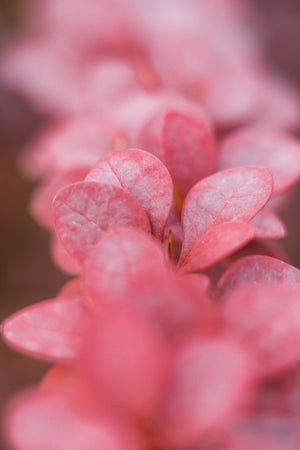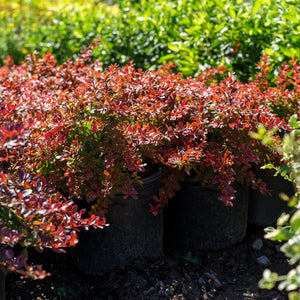The Barberry Guide
Barberry, known botanically as Berberis, is a versatile shrub appreciated for its vibrant foliage, compact growth habit, and resilience in a wide range of landscapes. Its thorny stems and bold color make it an excellent choice for hedging, foundation planting, and low-maintenance borders. With a wide variety of cultivars offering red, orange, yellow, or deep burgundy foliage, barberries provide year-round interest and can even serve as a focal point in modern or traditional garden designs.

About
Barberry belongs to the Berberidaceae family and includes both deciduous and evergreen species. Most commonly grown in North America is Berberis thunbergii, or Japanese barberry, which is valued for its dense habit, drought tolerance, and deer resistance. However, some cultivars such as Berberis × gladwynensis 'William Penn' offer evergreen or semi-evergreen options suited for milder climates.
Notable cultivars include Berberis thunbergii 'Crimson Pygmy', a compact, deep-red variety perfect for borders; 'Rose Glow', with pink mottled foliage that matures to purple; and 'Orange Rocket', known for its upright habit and fiery orange-red new growth. Varieties like 'Admiration' and 'Bogozam' offer a splash of gold and red tones in small spaces or container gardens. Barberries also provide seasonal interest with small yellow spring flowers and red or orange berries in fall, which attract birds.

PLANTING
Barberry shrubs are easy to establish and adaptable to various conditions:
- USDA Hardiness Zones: Most barberry varieties thrive in Zones 4–8, with some evergreen types suited for Zone 6 and warmer.
- Soil: Prefers well-drained soil, but tolerates a wide range including sandy, loamy, or clay types.
- Sunlight: Full sun promotes the most vibrant foliage, though partial shade is tolerated.
- Watering: Water regularly during the first growing season. Once established, barberry is drought tolerant.
- Spacing: Space plants 2 to 5 feet apart depending on variety size and intended use, such as hedges or specimen plantings.
- Planting Time: Best planted in spring or fall. Container-grown barberries can be planted any time the ground is workable.
Whether you’re creating a formal hedge or placing a bold specimen plant, barberry makes an easy-to-grow addition with striking impact.

CARE
Barberries are low-maintenance shrubs that benefit from occasional care to stay healthy and attractive:
- Pruning: Prune in late winter to early spring before new growth begins. Use gloves due to thorny branches. Remove dead or crossing stems and shape to maintain size.
- Fertilizing: Apply a slow-release, balanced fertilizer in early spring to support healthy foliage.
- Pest and Disease: Barberry is generally pest-resistant but may occasionally suffer from canker or aphid infestations. Remove affected branches and ensure good air circulation.
- Winter Care: Most deciduous varieties require no special winter care. Mulching helps insulate roots in colder regions.
- General Maintenance: Thin out interior growth every few years to allow light and air to reach the center of the shrub.
With just minimal effort, your barberry can remain a long-lived and visually striking part of your garden design.

HOW TO USE
Barberry’s compact form and vibrant hues make it an excellent tool in various landscape settings:
- Hedges and Borders: Use upright varieties like 'Orange Rocket' for low hedges, property lines, or security plantings due to their thorny stems.
- Foundation Plantings: Compact cultivars like 'Crimson Pygmy' or 'Bagatelle' frame entrances and paths with rich color.
- Rock Gardens: Smaller varieties blend well in sunny, dry spots and add bold contrast to stone textures.
- Containers: Dwarf barberries thrive in pots for patios or urban gardens.
- Accent Plants: Bold varieties like 'Rose Glow' or 'Admiration' make excellent focal points in mixed beds.
Barberry also pairs beautifully with contrasting textures like ornamental grasses, dwarf conifers, and broadleaf evergreens, creating vibrant seasonal compositions.

Common Questions
- How to get rid of canker on barberry bushes? Prune out affected branches well below the infection point, sterilizing tools between cuts. Improve air circulation and avoid overhead watering.
- What is barberry? Barberry is a genus of shrubs known for their colorful foliage, small flowers, and thorny stems. Many varieties are prized for ornamental landscaping.
- When to trim barberry bushes? Late winter or early spring is best, before new growth begins.
- How to prune barberry? Use clean, sharp tools and gloves. Shape the shrub, removing old stems and encouraging outward growth.
- Do deer eat barberry? Barberry is considered deer resistant due to its thorns and tough leaves.
- Is barberry toxic to dogs? While not highly toxic, barberries may cause mild digestive upset in pets if ingested.
- Is barberry toxic to cats? Yes, barberry can be mildly toxic to cats and may cause vomiting or drooling.
- Do rabbits eat barberry? Barberry is typically rabbit-resistant due to its thorns.
- Are barberries edible? Some barberry species produce berries that are edible when cooked and used in jams or herbal teas, but not all are palatable or safe raw.
- Is barberry evergreen? Some varieties, like Berberis × gladwynensis 'William Penn', are semi-evergreen or evergreen in warmer zones, while most Japanese barberries are deciduous.
- Is barberry invasive? Japanese barberry (Berberis thunbergii) is considered invasive in parts of the U.S. due to its tendency to self-seed and displace native plants.
Conclusion
Barberry is a bold, colorful shrub that adds year-round interest and structure to the garden. With its vibrant foliage, adaptability, and resistance to deer and drought, barberry can serve as a stunning hedge, a reliable filler for borders, or a striking focal point in mixed plantings. Whether you choose the compact charm of Berberis thunbergii 'Crimson Cutie' or the upright drama of 'Orange Rocket', there’s a barberry for nearly every garden setting.
The Barberry Collection
Sold Out
Sold Out
Sold Out






